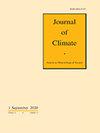Impact of the Winter Regional Hadley Circulation over Western Pacific on the Frequency of Following Summer Tropical Cyclone Landfalling in China
IF 4
2区 地球科学
Q1 METEOROLOGY & ATMOSPHERIC SCIENCES
引用次数: 0
Abstract
Abstract The poleward migration of tropical cyclone (TC) activity in recent years has been linked to the expansion of the Hadley circulation (HC). Here, we investigate the impact of the winter regional HC over the western Pacific (WPHC) on the frequency of following summer landfalling TC (LTC) in China. Results show that interannual variation of the LTC frequency has a very close connection with the northern WPHC edge (WPHCE). After removing the El Niño–Southern Oscillation signal, there still exists a significant correlation between them. When the winter WPHCE shifts poleward, the associated lower-level southwesterly (easterly) wind anomalies over the subtropical western Pacific (tropical central-eastern Pacific) induce sea surface temperature (SST) warming (cooling) anomalies therein via suppressing (enhancing) upward surface heat flux. In turn, the SST warming (cooling) excites an anomalous cyclonic (anticyclonic) circulation to its west via a Rossby wave response, thus maintaining the southwesterly (easterly) wind anomalies. In addition, the negative rainfall anomalies over the tropical central-eastern Pacific induced by negative SST anomalies can stimulate an anomalous intensive Walker circulation with anomalous upward motion around the tropical western Pacific. Through this positive air–sea interaction, the winter WPHCE signal would be preserved in the ocean and maintained to the succeeding summer, then favoring LTC genesis landward by decreasing the vertical wind shear and increasing the low-level vorticity and midlevel humidity. Meanwhile, anomalous midtropospheric easterly winds over the subtropics are favorable for steering more LTCs toward China’s coast. This study suggests that the winter WPHCE variation is a potential predictor for the prediction of the following summer LTC activity over China. Significance Statement Tropical cyclone (TC) is one of the most catastrophic high-impact weather events, which may cause great casualties and severe property losses over the coastal areas, particularly when it makes landfall. Previous research studies have related the poleward migration trend of TC locations to the Hadley circulation (HC) expansion. Compared to the long-term trend, the magnitude of the year-to-year change of the HC edge (HCE) is even larger, leading to a stronger impact on the TC activity. A recent study has suggested that the northern HCE over the western Pacific (WPHCE) in boreal winter exhibits a notable interannual variability. In this study, we reveal that the wintertime WPHCE has a very close connection with the landfalling TC (LTC) frequency over China in the following summer. After removing the El Niño–Southern Oscillation (ENSO) signal, there still exists a significant positive correlation between them. Observational evidence and numerical model experiments consistently confirm that this time-lagged association is attributable to the air–sea interaction processes in the tropical Pacific. Thus, the results of this study could provide an additional predictor besides ENSO to improve understanding of the LTC activity in China.西太平洋冬季区域哈德利环流对夏季热带气旋登陆中国频率的影响
摘要 近年来,热带气旋(TC)活动的极向移动与哈德利环流(HC)的扩张有关。在此,我们研究了西太平洋冬季区域HC(WPHC)对中国夏季登陆TC(LTC)频次的影响。结果表明,LTC 频率的年际变化与西太平洋高纬度环流北缘(WPHCE)有非常密切的关系。剔除厄尔尼诺-南方涛动信号后,二者仍存在显著的相关性。当冬季 WPHCE 向极地移动时,副热带西太平洋(热带中东太平洋)上空与之相关的低层西南(东)风异常会通过抑制(增强)上升的地表热通量而引起海面温度(SST)变暖(变冷)异常。反过来,海表温度变暖(变冷)又会通过罗斯比波反应激发西侧的异常气旋(反气旋)环流,从而维持西南(东)风异常。此外,负海温异常引起的热带中东太平洋负降雨异常也会刺激热带西太平洋周围异常的密集沃克环流,并产生异常的上升运动。通过这种积极的海气相互作用,冬季的 WPHCE 信号将在海洋中保留并维持到下一个夏季,然后通过减少垂直风切变和增加低层涡度和中层湿度,有利于 LTC 向陆地的生成。同时,副热带上空的中对流层异常偏东风有利于引导更多的 LTC 吹向中国沿海。这项研究表明,冬季 WPHCE 变率是预测中国夏季 LTC 活动的潜在指标。意义声明 热带气旋是最具灾害性的高影响天气事件之一,尤其是在登陆时可能会给沿海地区造成巨大的人员伤亡和严重的财产损失。以往的研究指出,熱帶氣旋位置向極地遷移的趨勢與哈德利環流擴張有關。与长期趋势相比,哈德利环流边缘的逐年变化幅度更大,对热带气旋活动的影响也更大。最近的一项研究表明,北半球冬季西太平洋北部 HCE(WPHCE)表现出明显的年际变化。在本研究中,我们发现冬季西太平洋北部 HCE 与翌年夏季在中国上空登陆的热带气旋(LTC)频率有非常密切的关系。剔除厄尔尼诺-南方涛动(ENSO)信号后,二者仍存在显著的正相关关系。观测证据和数值模式试验一致证实,这种时滞关联可归因于热带太平洋的海气相互作用过程。因此,本研究的结果可以提供除厄尔尼诺/南方涛动之外的另一个预测因子,以加深对中国长周期气候活动的理解。
本文章由计算机程序翻译,如有差异,请以英文原文为准。
求助全文
约1分钟内获得全文
求助全文
来源期刊

Journal of Climate
地学-气象与大气科学
CiteScore
9.30
自引率
14.30%
发文量
490
审稿时长
7.5 months
期刊介绍:
The Journal of Climate (JCLI) (ISSN: 0894-8755; eISSN: 1520-0442) publishes research that advances basic understanding of the dynamics and physics of the climate system on large spatial scales, including variability of the atmosphere, oceans, land surface, and cryosphere; past, present, and projected future changes in the climate system; and climate simulation and prediction.
 求助内容:
求助内容: 应助结果提醒方式:
应助结果提醒方式:


